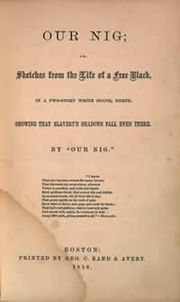- Our Nig
-
Our Nig 
Author(s) Harriet E. Wilson Country United States Language English Genre(s) Novel Publisher Geo. C. Rand & Avery Publication date 1859 Media type Print (Hardback & Paperback) Pages 131 pages ISBN ISBN 0-486-44661-5 (2005 paperback edition) Our Nig: Sketches from the Life of a Free Black is an autobiographical slave narrative by Harriet E. Wilson. It was published in 1859[1] and rediscovered in 1982 by professor Henry Louis Gates, Jr.. It is considered the first novel published by an African-American on the North American continent.[2][3]
Contents
Book sales
Our Nig did not sell well because of tension between the North and the South at the time. The northern abolitionists, who fought for freedom of the blacks, fought for a capitalist economy in the north. One of their arguments was that the capitalist economy could exist because it was working in the north without slave labor.[citation needed] Harriet Wilson disproves this because she shows that there is still slave treatment in the north except they were called indentured servants. David Dowling, a critic who wrote for College Literature wrote the piece "Other and More Terrible Evils: Anticapitalist Rhetoric in Harriet Wilson’s Our Nig and Proslavery Propaganda". He states that the northern abolitionists did not publicize her book because it disproved their theory. Wilson published her books two blocks from the Massachusetts Anti-Slavery Society.
According to John Ernest’s article, "Economies of Identity: Harriet E. Wilson’s Our Nig," Harriet E. Wilson’s novel, "Our Nig: Sketches in the Life of a Free Black," became marginalized by a white audience, and was perceived as appealing directly to a "colored audience". The distribution of "Our Nig: Sketches in the Life of a Free Black" was limited, and not appreciated by northern abolitionists, who would have normally accepted such slave narrative, due to the novels call for awareness of the abuse and "shadow of slavery" that existed even in the Northern United States.[4]
List of characters
- Mr. Bellmont - The patriarch of the Bellmont family. He is a kind and humble man who would not grudge hospitality to the poorest wanderer, nor fail to sympathize with any sufferer, however humble. He makes the ultimate decisions in the household, although they are challenged by Mrs. Bellmont. He is a man that seldom decides controversies at the home, but he ultimately declares that Frado go to school against Mrs. Bellmont’s protest. Although his intentions towards Frado are good, he does not exercise his ability as the patriarch to stop the cruel abuse against the child.
- Mrs. Bellmont-The matriarch of the Bellmont family. She is a tyrannical and capricious woman who never shows any mercy towards Frado. The members of the household live in fear of her erratic behavior. She is an abusive woman who takes Frado into the home because former servants could not bear her abuse. Mrs. Bellmont accepts Frado into her home, because having a black helper in her home is a status symbol. Mrs. Bellmont also influences her daughter Mary to physically and verbally abuse Frado.
- Mag Smith -
- Jim - A black man in love with a white woman; Mag, who has been taken advantage of by a man who left her after he stole her virginity. Mag is exiled because of distain and degradation, Jim is seen, as the escape she hopes will change her life. Jim marries Mag and they have two bi-racial children. Jim falls ill and eventually dies of consumption, leaving Mag alone again with the responsibility of raising two children.
- Seth Shipley - Once a partner in Jim’s business, Seth marries Mag and accompanies her to Singleton Hovel after Jim, her first husband, dies. Together, Seth and Mag leave their home and search for greener pastures; greater opportunity, and a chance for a better life. He and Mag abandon her young 6-year-old child, Fredo at the Belmont’s in an astonishing act of parental betrayal.
- Frado
- Mary Bellmont
- Jack Bellmont
- James Bellmont
- Samuel
See also
References
- ^ Wilson, Harriet E. (2004) [1859]. Our Nig: Sketches From The Life Of A Free Black. Kessinger Publishing. ISBN 1400031206. http://books.google.com/books?id=KeQ8tvxmlPYC&printsec=frontcover. Retrieved 2008-02-15.
- ^ Interview with Henry Louis Gates (mp3). Gates and a literary critic discuss Our Nig, Wired for Books
- ^ Our Nig: Sketches from the Life of a Free Black, Geo. C. Rand and Avery, 1859.
- ^ Ernest, John. "Economies of Identity: Harriet E. Wilson’s Our Nig." Modern Language Association. Vol. 109, No. 3. 1994. Pp 424-438. Jstor
External links
- Our Nig, electronic edition, University of Virginia Library
- Interview with Henry Louis Gates (mp3). Gates and a literary critic discuss Our Nig, Wired for Books
Categories:- Autobiographies
Wikimedia Foundation. 2010.
